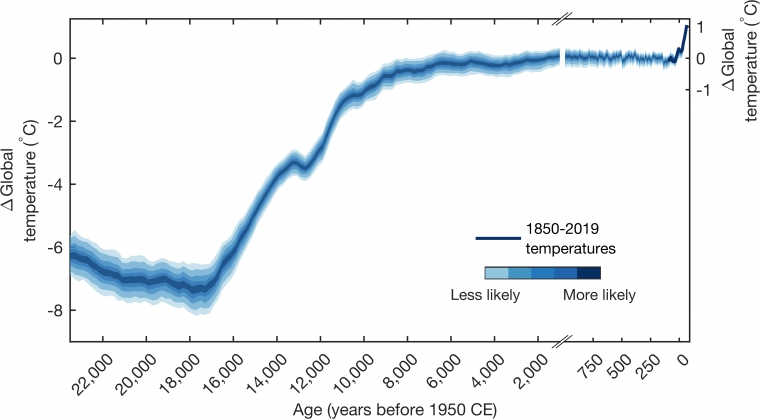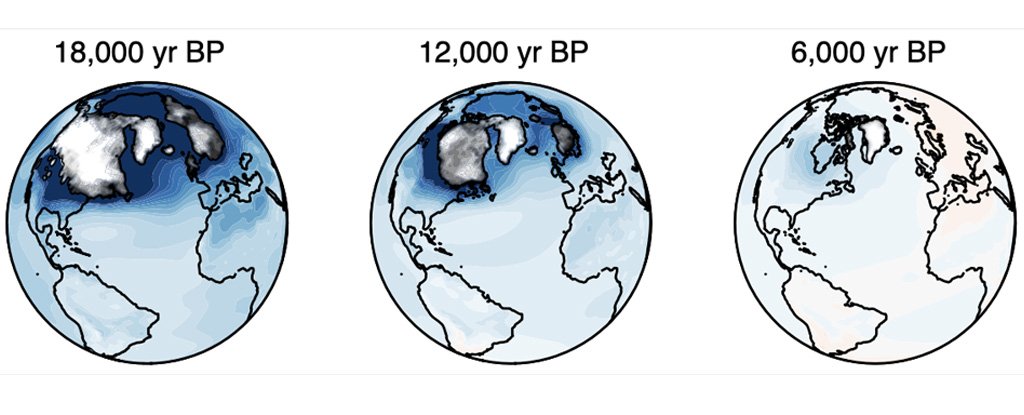The world is warming at an "extraordinary" pace unlike anything seen over the past 24,000 years, according to a new study that has amassed hundreds of temperature records from around the globe to map past climate change.
Reconstructing past temperatures from marine sediments dating back to the peak of the last ice age, the study reinforces – once again – humans have caused a shift in Earth's climate never before detected in the geological record.
"This reconstruction suggests that current temperatures are unprecedented in 24,000 years, and also suggests that the speed of human-caused global warming is faster than anything we've seen in that same time," says Jessica Tierney, a paleoclimatologist at the University of Arizona and co-author of the study.
The findings underscore the latest report from the UN's Intergovernmental Panel on Climate Change (IPCC), released in August, which concluded that burning fossil fuels has heated the planet at a rate unprecedented in the past 2,000 years, such that human influence on Earth's climate is simply "unequivocal".
"The fact that we're today so far out of bounds of what we might consider normal is cause for alarm," adds lead author of the new paper, climate scientist Matthew Osman, also of the University of Arizona.
In this new study, Tierney, Osman and colleagues analyzed a staggering 539 paleoclimate records, dating back at least 4,000 years each and together spanning the past 24,000 years – from the peak of the last ice age (aka the Last Glacial Maximum) when vast ice sheets covered most of the Northern Hemisphere, to today.
Global temperatures for the last 24,000 years. #climate #paleoclimate #NSFfunded @UA_Climate @uazgeosciences @uarizona pic.twitter.com/agrTDUQGLg
— Jessica Tierney (@leafwax) November 10, 2021
Looking at geochemical signatures in marine sediments, sampled from coastlines and seafloors around the globe, the researchers inferred historical temperatures and used this so-called proxy data to update climate model simulations that are becoming increasingly sophisticated but still depend on data inputs.
Past attempts to reconstruct global temperatures over millennia have either focused on very narrow time windows, to hone in regional variability, or studied temperature changes averaged out over the globe, to get a big picture view of how Earth's climate has changed over time.
"The benefit of this [new] hybrid approach is that the proxy data bring the model closer to reality, and the model fills in gaps where no data are available," Shaun Marcott of the University of Wisconsin-Madison and Jeremy Shakun of Boston College, explain in a commentary about the study.
In graphs charting global temperature, the likes of which we've seen before, sharp temperature increases in the last 150 years are a sudden departure from earlier, gradual warming, the study shows.
The results "imply modern warming is extraordinary compared with that of the past 10,000 years," Marcott and Shakun add.

lobal average surface temperature since the last ice age (Osman et al.)
What's more, mapping global temperature changes around the world in 200-year intervals as ice sheets retreated and greenhouse gases soared provided a more "complete view of climate change" on Earth over the past 24,000 years, the study authors write.
There should be no surprise their analysis found that rising levels of greenhouse gases and the retreat of vast ice sheets are the two main drivers of climate change since the last ice age, but their maps of global temperature change do add something new.
"With them, it's possible for anyone to explore how temperatures have changed across Earth, on a very personal level," Osman says. As you can see below, the darker the shade of blue, the colder the temperature compared to today.

Maps of global surface temperatures over 24,000 years (Osman et al. 2021).
"For me, being able to visualize the 24,000-year evolution of temperatures at the exact location I'm sitting today, or where I grew up, really helped ingrain a sense of just how severe climate change is today," Osman says.
Alas, Pacific Islanders who are already feeling the impacts of climate change need no such maps to understand what's at stake or how their homelands are changing.
There are also some technical limitations of the study worth noting. Just one climate model was used, which is not ideal, and no terrestrial data were included, only marine records – with very few data sourced from the central Pacific, Indian, and Southern oceans at that.
Nevertheless, the new study bolsters previous estimates of global temperature change produced from smaller amounts of data – the patterns of global heating through time, across the globe and in both hemispheres, are all very much alike, Marcott and Shakun write.
The team are now looking to apply their approach to ancient climates that were warmer than today, Tierney says, "because these times are essentially windows into our future as greenhouse gas emissions rise."
But as climate scientists keep stressing, the future climate is not a done deal. Every fraction of a degree of heating matters in our efforts to cut carbon emissions and avert the worst impacts of climate change.
"The climate we experience in the future depends on our decisions now," climatologist Valérie Masson-Delmotte told Nature in August upon delivering the sixth IPCC report.
There's no time to waste.
The study was published in Nature.
- Karlston and scarabou
-

 2
2



Recommended Comments
There are no comments to display.
Join the conversation
You can post now and register later. If you have an account, sign in now to post with your account.
Note: Your post will require moderator approval before it will be visible.